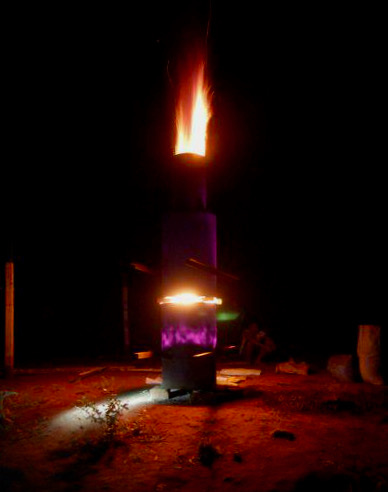Chapter 4 - Summary of research on biochar adsorption of chemical pollutants
Section summary and broader impacts
Night-time drum oven burn, Hsa Kaw Hser (“Border Star”) Learning Centre, Umphang, Thailand, April 2012.
To reiterate the main lesson from the preceding sections: from an adsorption perspective, not all biochars are created equal. Can traditional kiln charcoals and other conventional anaerobic pyrolysis biochars be used trace organic pollutants in water treatment? Yes, but with some important caveats. First, low temperature (350 to 500 Celsius) biochars should be avoided, as they have little adsorption capacity and contain a significant amount of incompletely carbonized material that can leach into water and cause unappealing appearance, taste, and odor, and possibly present a health concern. Second, high temperature (at least 850 Celsius) biochars produced under conventional anaerobic conditions have, at best, only about one-tenth the trace pollutant adsorption capacity of biochars produced under partially aerobic conditions such as in a gasifier. This difference in adsorption capacity can be offset by designing a larger biochar contactor, and/or replacing the biochar with greater frequency – but this comes with additional materials and labor costs.
The advantage in adsorption capacity gained by switching from a traditional horizontal drum kiln to a vertical TLUD gasifier drove my total conversion to this method of generating water treatment biochar. But the drum gasifier method has had impacts beyond the realm of water treatment. When I first started making gasifier biochar, my Thai contrarian farmer friend Pi Jo told me that it wouldn’t work. Scowling at my (badly) hand-drawn rendering of the prototype drum oven I planned to build he judged, “You can’t make charcoal that way – it will all burn up.” But both Pi Jo and I are incorrigible tinkerers and experimenters, so he didn’t object to me trying it anyway, despite his pessimism. In fact, it worked so well that I ended up making all the biochar needed to install fresh adsorbent in the Pun Pun treatment system that year. After a dozen-or-so batches I felt I had the hang of it, so I set up a tripod and camera to film the process and narrate a tutorial. You can find that video here:
Pi Jo walked by when I was in between filming segments and asked if I was making charcoal with the “strange method.” I said yes, it was working well, and gestured to the large pile of bagged char I’d produced over the past couple of weeks. He was stunned: “It’s running right now? There’s no smoke!” I said “Yeah, the gasifier burns the smoke.” He asked how long it took to convert a whole drum to charcoal. I replied “About two hours.” Again he was stunned. “Only two hours, and there’s no smoke?!?!” He noticed my video setup and asked if we make another video for him to narrate in Thai language? I said, “Sure thing!”
Since then Pi Jo has been featured in several videos about making gasifier charcoal/biochar, and other videos about setting up water treatment systems. One of his earlier Thai language videos on charcoal making has racked up nearly a million views:
Last summer he posted an English language video that was viewed over two million times in the first six months:
Every time I see Pi Jo he tells me how much the drum oven and water systems have spread throughout Thailand. The shorter burn time and absence of operator-harassing smoke have driven the viral, grassroots spread of this technique for making cooking charcoal as well as adsorbent biochar.
In sum, the low emissions, shorter burn time, flexibility for using a wide array of biomass feedstocks, and the ability to generate consistent adsorbent rivaling the batch-test performance of gold-standard commercial activated carbon make a strong case for preferring the gasifier technique over traditional kiln methods.
In the next section we review cutting-edge research on methods for pretreating biochar feedstocks to further boost organic trace pollutant adsorption capacity.

